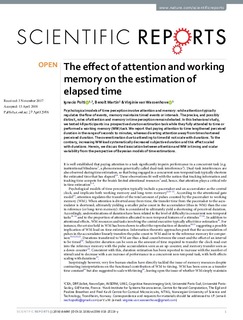| dc.contributor.author | Polti, Ignacio | |
| dc.contributor.author | Martin, Benoit | |
| dc.contributor.author | van Wassenhove, Virginie | |
| dc.date.accessioned | 2019-03-18T16:11:50Z | |
| dc.date.available | 2019-03-18T16:11:50Z | |
| dc.date.created | 2018-09-01T13:52:02Z | |
| dc.date.issued | 2018 | |
| dc.identifier.issn | 2045-2322 | |
| dc.identifier.uri | http://hdl.handle.net/11250/2590535 | |
| dc.description.abstract | Psychological models of time perception involve attention and memory: while attention typically regulates the flow of events, memory maintains timed events or intervals. The precise, and possibly distinct, roles of attention and memory in time perception remain debated. In this behavioral study, we tested 48 participants in a prospective duration estimation task while they fully attended to time or performed a working memory (WM) task. We report that paying attention to time lengthened perceived duration in the range of seconds to minutes, whereas diverting attention away from time shortened perceived duration. The overestimation due to attending to time did not scale with durations. To the contrary, increasing WM load systematically decreased subjective duration and this effect scaled with durations. Herein, we discuss the dissociation between attention and WM in timing and scalar variability from the perspective of Bayesian models of time estimations. | nb_NO |
| dc.language.iso | eng | nb_NO |
| dc.publisher | Nature Research | nb_NO |
| dc.rights | Navngivelse 4.0 Internasjonal | * |
| dc.rights.uri | http://creativecommons.org/licenses/by/4.0/deed.no | * |
| dc.title | The effect of attention and working memory on the estimation of elapsed time | nb_NO |
| dc.type | Journal article | nb_NO |
| dc.type | Peer reviewed | nb_NO |
| dc.description.version | publishedVersion | nb_NO |
| dc.source.volume | 8 | nb_NO |
| dc.source.journal | Scientific Reports | nb_NO |
| dc.source.issue | 1 | nb_NO |
| dc.identifier.doi | 10.1038/s41598-018-25119-y | |
| dc.identifier.cristin | 1606007 | |
| dc.relation.project | EU/ERC-YStG-263584 | nb_NO |
| dc.description.localcode | Open Access This article is licensed under a Creative Commons Attribution 4.0 International License, which permits use, sharing, adaptation, distribution and reproduction in any medium or format, as long as you give appropriate credit to the original author(s) and the source, provide a link to the Creative Commons license, and indicate if changes were made. The images or other third party material in this article are included in the article’s Creative Commons license, unless indicated otherwise in a credit line to the material. If material is not included in the article’s Creative Commons license and your intended use is not permitted by statutory regulation or exceeds the permitted use, you will need to obtain permission directly from the copyright holder. To view a copy of this license, visit http://creativecommons.org/licenses/by/4.0/ | nb_NO |
| cristin.unitcode | 194,65,60,0 | |
| cristin.unitname | Kavliinstitutt for nevrovitenskap | |
| cristin.ispublished | true | |
| cristin.fulltext | original | |
| cristin.qualitycode | 1 | |

